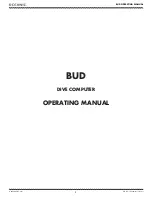
Chapter 3. Diagnostics
28
DigitalFlow™ GS868 Service Manual
3.3 Diagnostic Record
Upon leaving the
Diagnostic Menu
via the
[EXIT]
key or the
EXIT
option on the option bar, the display screen will
continue to show the last diagnostic parameter that was selected. To return to normal measurement mode, select a
channel to display (for a 2-Channel meter only) and then select the desired display parameter. See Chapter 3,
Operation
, of the
Startup Guide
for detailed instructions.
The values for the diagnostic parameters immediately after initial installation of the meter and verification of proper
operation should be entered in Table 7 in Appendix A,
Service Record
. These values can then be compared to future
values to help diagnose any future malfunction of the system.
3.4 Flowcell Problems
If preliminary troubleshooting with the
Error Code Messages
and/or the
Diagnostic Menu
indicates a possible flowcell
problem, proceed with this section. Flowcell problems fall into two categories:
•
gas problems
•
pipe problems.
Read the following sections carefully to determine if the problem is indeed related to the flowcell. If the instructions in
this section fail to resolve the problem, contact the factory for assistance.
3.4.1 Gas Problems
Most gas-related problems result from a failure to observe the flowmeter system installation instructions, as described
in the
Startup Guide
. Refer to Chapter 1,
Installation
, of the
Startup Guide
to correct any installation problems.
If the physical installation of the system meets the recommended specifications, it is possible that the gas itself may be
preventing accurate flow rate measurements. The gas being measured must meet the following requirements:
1. The gas must be homogeneous, single-phase and relatively clean.
Although a low level of entrained particles may
have little effect on the operation of the Model GS868, excessive amounts of solid or liquid particles will absorb or
disperse the ultrasound signals. This interference with the ultrasound transmissions through the gas will cause
inaccurate flow rate measurements. In addition, temperature gradients in the gas flow may result in erratic or
inaccurate flow rate readings.
2. The gas must not excessively attenuate ultrasound signals.
Some gases (i.e., high-purity carbon dioxide, hydrogen, nitrogen, etc.) readily absorb ultrasound energy. In such a
case, an
E1
error code message will appear on the display screen to indicate that the ultrasonic signal strength is
insufficient for reliable measurements.
3. The gas sound speed must not vary excessively.
The Model GS868 will tolerate relatively large changes in the gas sound speed, as may be caused by variations in
gas composition and/or temperature. However, such changes must occur slowly. Rapid fluctuations in the gas
sound speed, to a value that is considerably different from that programmed into the Model GS868, will result in
erratic or inaccurate flow rate readings. Refer to Chapter 2,
Initial Setup
, of the
Startup Guide
and make sure that
the appropriate sound speed is programmed into the meter.
Summary of Contents for DigitalFlow GF868
Page 2: ......
Page 4: ...ii no content intended for this page ...
Page 10: ...Contents viii DigitalFlow GS868 Service Manual ...
Page 26: ...Chapter 1 Calibration DigitalFlow GS868 Service Manual 16 ...
Page 40: ...Chapter 3 Diagnostics 30 DigitalFlow GS868 Service Manual no content intended for this page ...
Page 68: ...Warranty 58 DigitalFlow GS868 Service Manual no content intended for this page ...
Page 72: ......
Page 73: ......
















































